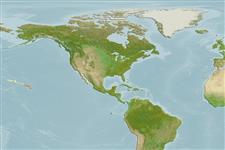Classification / Names
Common names | Synonyms | Catalog of Fishes(genus, species) | ITIS | CoL | WoRMS | Cloffa
Teleostei (teleosts) >
Pleuronectiformes (Flatfishes) >
Soleidae (Soles)
Etymology: Aseraggodes: Greek, aggos, -eos, -ous = vessel, uterus, carapace of a crab + Greek, aseros, -a, -on = to remove the appetite (Ref. 45335); holcomi: Named for Ronald R. Holcom..
More on author: Randall.
Environment: milieu / climate zone / depth range / distribution range
Ecology
Marine; demersal; depth range 1 - 27 m (Ref. 48239). Tropical
Distribution
Countries | FAO areas | Ecosystems | Occurrences | Point map | Introductions | Faunafri
Eastern Central Pacific: currently known only from the island of O'ahu.
Size / Weight / Age
Maturity: Lm ? range ? - ? cm
Max length : 3.6 cm SL male/unsexed; (Ref. 48239); 5.9 cm SL (female)
Short description
Identification keys | Morphology | Morphometrics
Dorsal soft rays (total): 68 - 75; Anal soft rays: 47 - 50; Vertebrae: 35 - 36. Ocular side without large, prominent dark blotches. Pectoral fins absent. Caudal peduncle present; branched fin rays 14. Dorsal- and anal-fin rays with a thin, membranous ridge on some rays, not extending more than halfway to ray tip. Head length 4.2-4.6 in SL; body thickness 2.5-3 in HL (Ref. 48239).
Benthic on sand near reefs (Ref. 58302).
Life cycle and mating behavior
Maturities | Reproduction | Spawnings | Egg(s) | Fecundities | Larvae
Randall, J.E., 2002. Aseraggodes holcomi, a new sole (Pleuronectiformes: Soleidae) from the Hawaiian Islands. Pac. Sci. 56(3):247-253. (Ref. 48239)
IUCN Red List Status (Ref. 130435)
Threat to humans
Harmless
Human uses
Tools
Special reports
Download XML
Internet sources
Estimates based on models
Preferred temperature (Ref.
123201): 24.8 - 25.6, mean 25.3 °C (based on 34 cells).
Phylogenetic diversity index (Ref.
82804): PD
50 = 0.5000 [Uniqueness, from 0.5 = low to 2.0 = high].
Bayesian length-weight: a=0.00977 (0.00473 - 0.02021), b=3.07 (2.90 - 3.24), in cm total length, based on LWR estimates for this (Sub)family-body shape (Ref.
93245).
Trophic level (Ref.
69278): 3.4 ±0.5 se; based on size and trophs of closest relatives
Resilience (Ref.
120179): High, minimum population doubling time less than 15 months (Preliminary K or Fecundity.).
Fishing Vulnerability (Ref.
59153): Low vulnerability (10 of 100).
